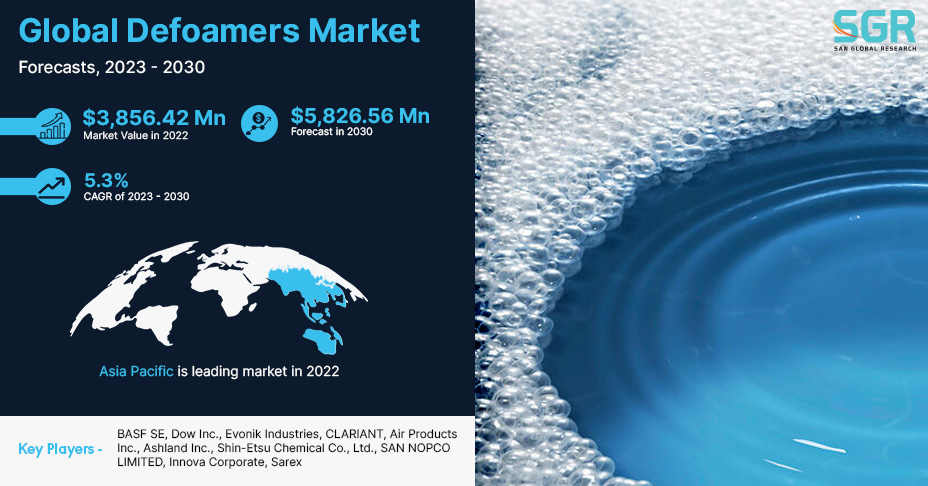Discover the Environmental Impact of Defoamers in Industrial Applications
Discover the Environmental Impact of Defoamers in Industrial Applications
Blog Article
The Duty of Defoamers in Enhancing Product Top Quality and Performance
Defoamers serve as essential ingredients that mitigate this concern, making sure smoother manufacturing workflows while enhancing the aesthetic and useful attributes of the final items. The choice of the proper defoamer can be important to attaining ideal outcomes, elevating crucial concerns about formulation compatibility and efficiency metrics that warrant additional expedition.
Recognizing Defoamers
Comprehending the duty of defoamers is essential for preserving product top quality throughout numerous sectors. Defoamers are chemical additives developed to prevent the development and lower of foam in fluid systems, which can adversely impact processes such as blending, filling up, and surface area stress. Lathering can lead to inadequacies, product issues, and endangered visual appeal, making defoamers an essential part in making operations.
In industrial applications, defoamers assist to improve product consistency and security. For instance, in the paint and layers industry, foam can disrupt the application procedure and the final coating. In food and drink manufacturing, extreme foam can impede bottling and packaging performance. The efficient use defoamers not just makes certain smoother manufacturing procedures yet additionally adds to remarkable product efficiency.
In addition, the choice and solution of a defoamer must straighten with particular application demands, such as compatibility with other components, performance under differing temperature and pH conditions, and potential regulatory restraints. Eventually, recognizing defoamers' functions and their value in different formulas is critical for maximizing manufacturing and ensuring the finest final product.
Kinds Of Defoamers
Defoamers can be classified into several types based on their composition and device of activity. The primary types include silicone-based, non-silicone natural, and not natural defoamers.
Silicone-based defoamers are amongst the most efficient, mostly as a result of their capability to spread out promptly on the liquid surface and interrupt foam development. Their distinct chemical framework enables premium stability, making them suitable for high-temperature applications and settings with differing pH levels.
Non-silicone natural defoamers, usually composed of all-natural oils or fatty acids, are valued for their biodegradability and lower toxicity. These are commonly made use of in food and beverage applications where safety and ecological impact are extremely important.
Not natural defoamers, which consist of materials like talc or calcium carbonate, act by raising the thickness of the liquid, therefore reducing foam stability. They are usually utilized in industrial procedures where compatibility with other materials is not a concern.
Each kind of defoamer has unique advantages and restrictions, enabling for tailored remedies depending on the certain frothing problems encountered in numerous applications. Recognizing these differences is essential for optimizing performance and accomplishing wanted item high quality.
Applications Across Industries
Various sectors take advantage of defoamers to boost item quality and functional performance. In the food and beverage market, defoamers are important in procedures such as developing and milk production to prevent foam development, which can result in ineffectiveness and item inconsistency. By managing foam, suppliers can guarantee far better return and a more uniform product.
In the pharmaceutical market, defoamers play an important function in the solution of liquid drugs, continue reading this where excessive foam can restrain blending and accurate application. Their use assists preserve the stability of the formulations and promotes smoother manufacturing processes.
The paint and finishes sector also relies on defoamers to boost the performance of items during application. By minimizing foam, these additives guarantee a smoother coating and improve the aesthetic qualities of the end product.

Benefits of Using Defoamers
While the application of defoamers varies throughout industries, their benefits continually enhance item high quality and procedure effectiveness. One considerable benefit is the reduction of foam formation during producing procedures, which can otherwise bring about manufacturing delays and incongruities in item top quality. By lessening foam, defoamers enable a smoother circulation of products, facilitating much more effective procedures and decreasing the likelihood of tools malfunctions.
In addition, making use of defoamers can enhance the appearance and appearance of end products. In industries such as finishings, paints, and food handling, excessive foam can compromise the visual aesthetics and total top quality, while the suitable defoamer application ensures a consistent coating and desirable characteristics. Moreover, defoamers can contribute to set you back financial savings by decreasing waste during production and enhancing making use of raw products (defoamers).
Selecting the Right Defoamer
Picking the appropriate defoamer is essential for optimizing production procedures and guaranteeing product top quality. The choice of defoamer influences not only the effectiveness of foam control but also the general efficiency characteristics of the end product. Variables to think about include the sort of application, the chemistry of the solution, and the ecological conditions under which the item will be used.
Various sectors might require particular defoamer types, such as silicone-based, organic, or polymeric defoamers. Recognizing the compatibility of the defoamer with the main components is important to prevent damaging reactions that could jeopardize product integrity. Furthermore, the defoamer's efficiency in Going Here different temperature levels and pH degrees have to be examined to guarantee constant efficiency.
Evaluating the defoamer in small-scale applications can offer beneficial insights into its efficiency and viability. Factor to consider of regulatory conformity, especially in food, drugs, and cosmetics, is extremely important in read the article choosing a defoamer. Eventually, a comprehensive evaluation of these aspects will certainly bring about the choice of a defoamer that not only regulates foam effectively however likewise boosts the top quality and efficiency of the last item.
Conclusion

In verdict, defoamers are essential ingredients that significantly boost product quality and performance across different industries. The tactical option and application of defoamers lead to cost savings, optimized source use, and increased consumer complete satisfaction.
Lathering can lead to inefficiencies, product problems, and endangered visual charm, making defoamers a critical part in manufacturing operations.

Report this page